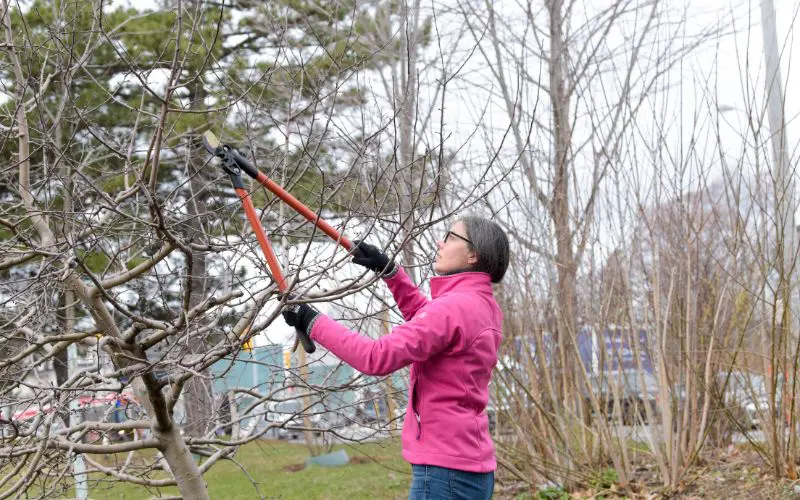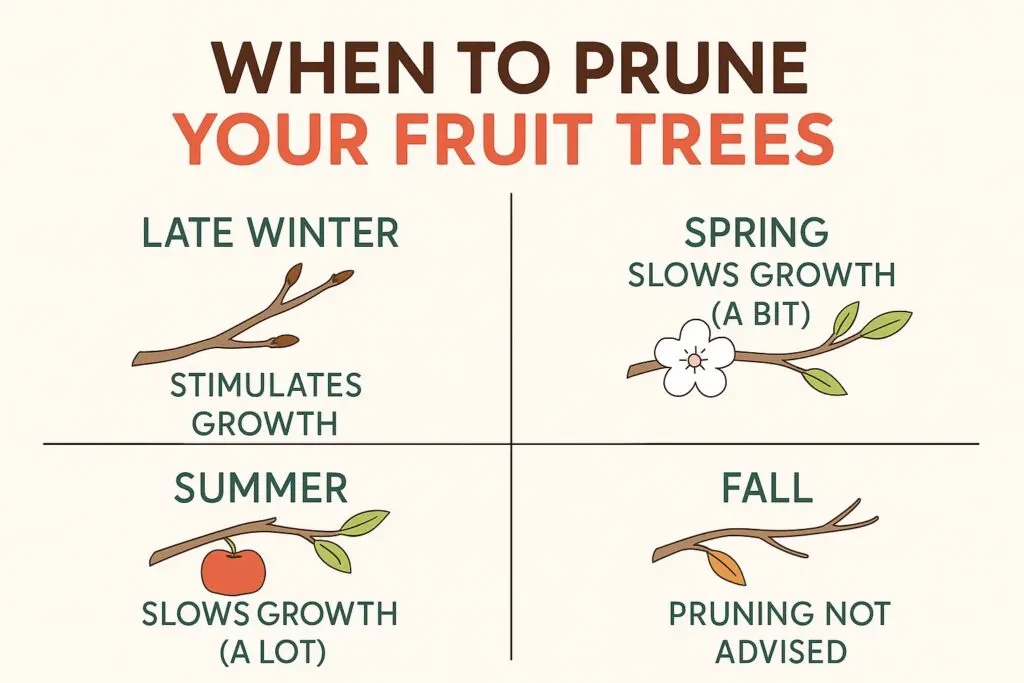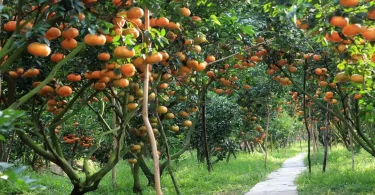Understanding the Basics of Fruit Tree Pruning
Prune fruit trees is essential for encouraging healthy growth and maximizing fruit production. You need to start by focusing on the tree’s structure. Begin by removing dead, damaged, or diseased branches to prevent pests and improve airflow. Cutting away suckers and water sprouts, which drain nutrients, helps direct the tree’s energy toward productive branches.
Understand growth patterns; fruit often forms on specific parts of branches depending on the species. Use sharp, clean tools, such as bypass pruners or loppers, for precise cuts. Avoid over-pruning to maintain balance between growth and fruit production. Proper timing is vital, typically late winter or early spring for most trees.

The Benefits of Pruning for Annual Fruit Yield
Pruning offers several essential benefits that directly influence the quantity and quality of fruit yield in your orchard. When you prune correctly, you:
- Enhance Sunlight Penetration: Removing crowded or excess branches ensures sunlight reaches every part of the tree, promoting better photosynthesis and fruit development.
- Encourage Healthy Growth: Thinning weak or damaged branches allows the tree to focus its energy on producing stronger, more productive limbs.
- Improve Air Circulation: Better airflow reduces the risk of fungal diseases, which can significantly impact fruit yield.
- Manage Tree Size: Proper pruning makes it easier to harvest fruit by maintaining a manageable tree height and shape.
- Stimulate New Growth: Cutting older, less productive branches encourages the emergence of new shoots, which often bear more fruits.
Best Tools and Equipment for Effective Pruning
To prune fruit trees effectively, you need to have the right tools at your disposal. Below is a list of essential pruning equipment and their uses:

- Pruning Shears: Choose bypass shears for clean cuts on small branches or stems up to ¾ inch thick. Keep them sharp to prevent strain on the tree.
- Loppers: These handle thicker branches (1-2 inches in diameter) and offer extended reach for high spots.
- Pruning Saw: Ideal for larger, tougher branches; look for a curved or folding design for easier use.
- Pole Pruners: Perfect for removing branches from tall trees without a ladder.
- Gloves and Protective Gear: Protect your hands and eyes from scratches and debris during pruning.
Maintain your equipment regularly for optimal performance.
When is the Right Time to Prune Fruit Trees?
Timing is crucial when pruning fruit trees to promote healthy growth and maximize yields. You should aim to prune during the dormant season, typically late winter to early spring, before new growth begins. This period allows the wounds to heal without interference from diseases or pests active during warmer months. Avoid pruning during fall, as it can stimulate new growth vulnerable to winter damage.

For summer pruning, focus on controlling growth and improving sunlight penetration. Be cautious not to over-prune, as it can weaken the tree. Always tailor your pruning schedule to your tree’s specific variety and growth pattern.
Key Principles for Shaping Healthy Tree Structure
- Choose a Strong Central Leader: Identify and maintain a dominant central trunk to create a balanced, sturdy structure for your fruit tree. This ensures proper energy distribution and supports healthy growth.
- Space Out Scaffold Branches: Prune to form evenly spaced primary limbs, known as scaffold branches, around the central trunk. This promotes light penetration and air circulation, reducing disease risk.
- Remove Competing Branches: Eliminate branches that cross, rub, or compete for sunlight. This keeps the tree open and prevents overcrowding.
- Focus on Angles: Keep branch angles between 45° and 60° to strengthen their attachment. Narrow angles can weaken the tree and lead to breakage under fruit weight.
- Encourage Symmetry: Prune to achieve uniformity in branch spacing and distribution, ensuring balanced growth. A symmetrical tree structure maximizes yield and stability.
Step-by-Step Guide to Pruning Young Fruit Trees
- Select the Right Tools Use sharp, clean pruning shears, loppers, or a small saw to ensure clean cuts. Avoid dull tools, which can damage branches or spread disease.
- Prune During Dormancy Perform pruning in late winter or early spring when growth is dormant. This reduces stress on the tree and helps promote healthy new growth.
- Remove Dead or Damaged Wood Identify and cut away any broken, diseased, or dying branches. This prevents infection and redirects energy to healthy parts.
- Shape the Tree Trim branches to encourage an open, vase-like structure, allowing sunlight and air circulation through the canopy for better fruit production.
- Focus on Central Leader Maintain a single strong central leader for most fruit trees to ensure balanced growth and support developing fruit.
- Cut Competing Shoots Remove any shoots growing directly upward or crossing over others. This minimizes competition and reduces overcrowding.
- Avoid Over-Pruning Be careful not to remove more than 25% of the tree. Excessive cuts can stress the tree and impact future yields.

Techniques for Maintaining Mature and Established Trees
When pruning mature trees, focus on maintaining their structure and productivity. You should start by removing dead, diseased, or damaged branches to prevent the spread of infections.
Thin out crowded areas to improve air circulation and sunlight penetration. Use the “three-cut method” for large branches to avoid tearing the bark.
Keep lateral branches at wide angles as they are stronger and bear more fruit. Assess tree height and prune the top to manage growth while ensuring accessibility for harvesting.
Avoid heavy cuts in a single season; instead, spread pruning work over several years. Always sterilize tools between cuts to minimize disease transmission.
Dealing with Common Pruning Challenges and Mistakes
When pruning fruit trees, you may encounter frequent challenges. Over-pruning can stress the tree, so aim to remove no more than 25% of the canopy in a single session. Ensure you’re identifying dead, diseased, or crossed branches accurately to avoid cutting healthy growth mistakenly. If you use dull or improper tools, you risk tearing branches, leaving openings for pests and diseases. Failing to understand the growth habits of your tree can lead to pruning at the wrong time or cutting productive wood. Always sanitize your pruning tools between cuts to prevent spreading disease to other parts of the tree or neighboring plants.
Seasonal Maintenance: Adapting Your Pruning Strategy
Understanding how fruit trees respond to seasonal changes will help you optimize your pruning efforts. In winter, focus on removing dead or diseased wood and shaping the tree, as it’s dormant and healing is slower. Late winter or early spring is ideal for structural pruning, encouraging healthy growth. During summer, thin out crowded branches to improve airflow and sunlight penetration while promoting fruit development. Avoid heavy pruning in fall, as it may trigger unwanted growth before winter dormancy. Tailor your pruning techniques to match each season’s demands, ensuring the health and productivity of your fruit trees throughout the year.

Promoting Long-Term Health and Productivity of Your Trees
Proper pruning not only enhances fruit yield but also supports the long-term health of your trees. You need to target dead, diseased, or damaged branches as these can hinder growth and spread pathogens. Removing crowded or crossing limbs improves airflow and sunlight penetration, which boosts photosynthesis. Thin out excess shoots to prevent nutrient competition and redirect energy to fruit production. Always prune during the dormant season to minimize stress and reduce the risk of infections. Invest in sharp, clean tools to make precise cuts and avoid tearing bark. Consistent care ensures your trees thrive year after year.
How to Identify and Remove Dead or Diseased Branches
To identify dead or diseased branches, look for signs such as discolored bark, brittle wood, or a lack of leaves during the growing season. Diseased branches may show irregular spots, oozing sap, or fungal growth. Use a pruning saw or shears cleaned with rubbing alcohol to prevent spreading disease.
Remove dead branches back to the main trunk or a healthy lateral branch. Avoid leaving stubs, as they attract pests and diseases. Cut diseased branches at least 6–12 inches below the affected area, ensuring clean, precise cuts to promote proper healing. Discard infected wood properly to prevent contamination.

Balancing Growth and Yield Through Selective Pruning
When pruning fruit trees, focus on removing excess growth to direct the tree’s energy towards producing fruit rather than unproductive foliage. Use selective pruning to eliminate crossover branches, dead wood, and suckers that sap nutrients. This process helps open the canopy, improving sunlight penetration and air circulation, which reduces disease risk and enhances fruit quality.
Prioritize cuts that shape the tree’s structure for balanced growth. Target upward-growing branches or vertical shoots (water sprouts) that compete with fruiting wood. Maintain a balance by leaving enough buds to ensure future yield while stimulating strong, healthy shoots. Prune consistently and strategically for optimal results each growing season.
Maximizing Yield with Advanced Pruning Techniques
To achieve higher yields, apply advanced pruning techniques that go beyond basic cuts. Start by identifying the tree’s growth habit, as this determines where to focus your efforts. Use the thinning method to remove excess branches, ensuring sunlight reaches all parts of the canopy for optimal fruit development.
Perform heading cuts on vigorous shoots to direct energy to fruit-bearing wood, promoting productive growth. Incorporate renewal pruning, targeting old, unproductive branches to encourage new spur formation.
Always sterilize your tools between cuts to prevent the spread of disease. Fine-tune the approach annually, observing the tree’s response to adjustments. Create balance by checking both fruiting and vegetative areas during pruning sessions.

Post-Pruning Care and Fertilization Tips
After pruning, you must focus on promoting healthy regrowth and ensuring the tree is well-nourished. Begin by inspecting the tree for any wounds caused during pruning. Use a pruning sealer only if necessary, as most cuts heal naturally in proper conditions.
To enhance recovery:
- Water adequately: Ensure the soil remains moist but not waterlogged. Deep watering is ideal for fostering strong roots.
- Apply mulch: Add a 2–3-inch layer around the base. This helps retain moisture and regulate temperature.
- Fertilize wisely: Use a balanced fertilizer with nutrients like nitrogen, phosphorus, and potassium. Apply in early spring following pruning.
Always monitor for pests and diseases and address them promptly.
Monitoring Progress to Ensure Yearly Fruit Production
To maintain yearly fruit production, regular monitoring is essential. After pruning, keep an eye on the tree’s health and growth patterns. Check for signs of stress, such as wilting leaves or reduced growth, as these may indicate the pruning was too aggressive. Ensure you track flowering and fruit development stages each year.
- Inspect branches: Look out for damaged, diseased, or excessively shaded areas.
- Evaluate fruit quality: Take note of the size, taste, and yield of the fruit.
- Adjust pruning methods: Modify techniques if production declines or branches become overcrowded.
By consistently observing your tree’s performance, you can refine your approach for optimal results.



